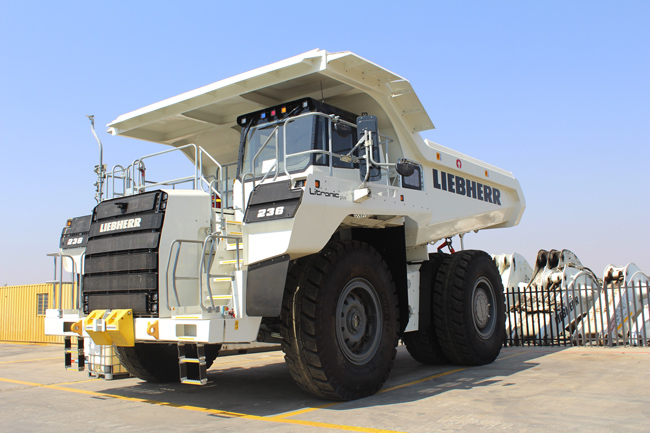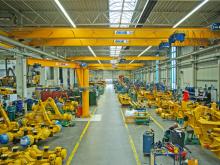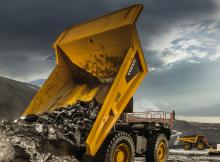
Following the completion of field operation trials in Austria, the first
While it is ideally suited to the mining sector, Liebherr Africa is also targeting large-scale quarrying operations with the new 100 tonne truck. Tom Munch, Director Mining, says the new rigid hauler arrives at an opportune time for Liebherr Africa. “We are working in a contract mining market. If you look at the type of equipment this group of customers requires currently, it’s mainly 100 tonne excavators and 100 tonne dump trucks. This is due to the mobility they require, given that their contracts are limited to 3-5 years at most,” says Munch.
Munch adds that Liebherr also urgently needed a truck to complement its excavator range. Designed to carry up to 100 tonnes of payload, the T236 can be ideally paired with Liebherr’s R 9100, R 9150, R 9200 or R 9250 mining excavators.
Munch reasons that the T236 is ideally suited for the contract mining market because it speaks directly to lower cost per tonne, increased productivity and safety, three key parameters of sheer significance to contractors, especially in light of the current tight operating conditions.
Mining and quarrying companies have spent many years ruthlessly seeking ways to reduce their operating costs. One of the measures they have implemented is supply chain optimisation. In a bid to control their costs, many have tightened their contractor service level agreements. For example, many mines and quarries have put a fuel cap on each and every contractor’s machine. If a machine exceeds its fuel cap, the extra fuel consumption will be deducted off the mining contractor’s certificate.
Donald Hewitt, national service manager – mining at Liebherr Africa, says probably 60-70% of mining contracts awarded today have a fuel cap. Previously, “wet contracts” had no limit on fuel and contractors were not so concerned by the fuel efficiency of their machines. Today, mining contractors are being forced to rank fuel consumption high up on their buying checklists. With a range of fuel-saving innovations, the T236 will surely address these concerns.
Abie Kriel, technical manager – mining at Liebherr Africa, says the T236 sets a new era by becoming the first truck in the 100 tonne segment to utilise a diesel-electric drive system. A major talking point is Liebherr’s Litronic Plus Generation 2 drive system, which introduces the advanced Active Front End technology. Making use of electrical energy during retarding events, the drive system is able to deliver controlled engine speed, controlled decent speeds via speed control and active braking.
“The Active Front End control and electric drive work in harmony to use less fuel and cause less wear on components, translating into greater cost-savings,” says Kriel. “As the first diesel-electric truck in the 100 tonne class to incorporate an oil immersed braking system with four-corner braking control, the T236 is geared to deliver sound reliability and performance, even in tough operating conditions.”
Christopher Vorster, national sales manager – mining at Liebherr Africa, says with its high take-off torque and continuous power-to-ground capability, the T 236 is less sensitive to grade and payload variations, resulting in greater productivity.
Vertical integration of Liebherr designed and manufactured components ensures that the truck’s powertrain achieves optimal system efficiency and performance throughout the full range of applications. The truck’s innovative, variable hydraulic system lowers machine parasitic losses to provide maximum power, while lowering fuel consumption when power is not required.
“Powered by a Cummins QST30-C engine, the T264 reduces fuel consumption due to its low parasitic powertrain losses. Optimised energy consumption during propulsion ensures the Liebherr T236 makes efficient use of constant engine power, providing the lowest possible fuel consumption,” explains Vorster. “Efficiency is a key ingredient for a successful mining operation. This truck enables customers to enjoy unrivalled performance while reducing cost per tonne.”
Hewitt adds: “During retard, the power generated by the wheels is used to increase parasitic energy consumption and reduce truck speed by engine friction, while controlling the engine speed anytime.”









